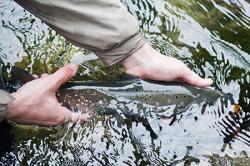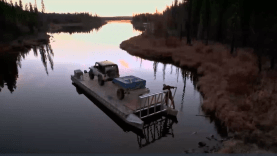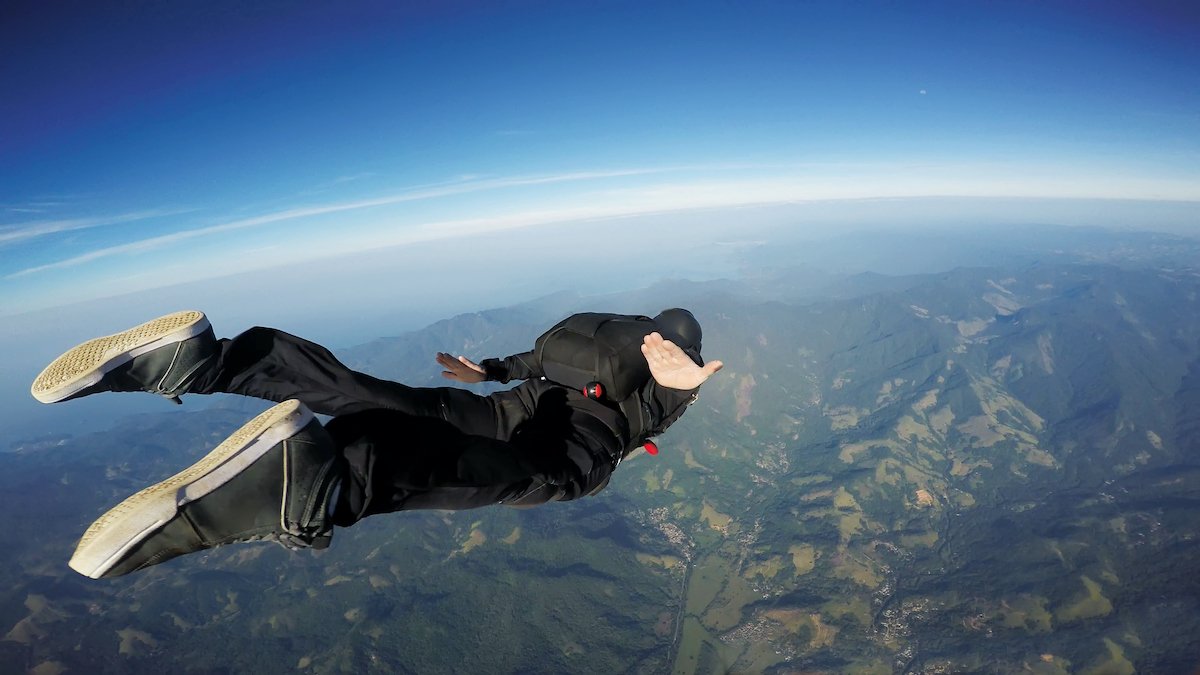

Most people have had the chance thought that maybe they’d like to go skydiving. Some of them may even book a spot. They might find that there is a big difference between wanting to skydive and actually skydiving. A lot can happen, mentally, as you fly higher and higher inside a plane that you’ll shortly jump out of.
This is why mental preparation is vital for any extreme sport. Besides allowing you to participate safely, it may be what enables you to participate at all. There’s nothing wrong with riding the plane back down if you decide skydiving isn’t for you, but if it’s something you were excited about and you back down because your fears won, that’s just a small tragedy.
To help you prepare for extreme adventures of your own, I’ve consulted with some experts. Sarah Kehrli is a skydiver with a background in wilderness therapy, and Jackson Kramer is an alpine and splitboard guide and educator. Their advice will help guide you as you gear up to summit a mountain or as you jump out of a plane with nothing but a couple parachutes on your back. Let’s make sure you’re in the right headspace before you go.

Do Your Due Diligence
There are some ways in which the physical prep and the mental prep for your extreme adventure will overlap. In a mountaineering context, as Jackson prepares to guide people up peaks like Whitney, Rainer, and Baker, he’s checking weather. He looks at the days he’s planning to climb as well as the prevailing trends. He’ll check avalanche reports, inspect his gear, and have a route generally mapped out, along with knowledge of the surrounding area.
When I asked Sarah about safety routines and gear checks, she said, “Gear checks are sexy, so we do ‘em.” She makes a point to have a friend take a look before getting on the plane, though that wasn’t always the case. After one jump, she discovered that her chest strap was twisted, which didn’t cause any problems for that jump, but it is something that could potentially have been an issue. Now, she’s more intentional, making sure all of her handles are stowed correctly, things are tucked into the right place, and her automatic activation device is on, so she knows she’s ready to fly.
You should allow your physical preparation to inform your mental preparation. When you’re in the thick of it, about to jump or halfway up your ascent, there is a vital peace of mind that comes with knowing you’ve done what you can to be ready for this.
Consider Your ‘Whys’
There’s two notable “whys” when it comes to mentally preparing for extreme adventures. The first relates to your physical safety, understanding the gear and resources you’ll be using to answer the question “Why is this safe?” The second has more to do with your own personal motivations—i.e., “Why am I doing this?”
Why Is This Safe?
Jackson offers full transparency to the people he’s guiding. He’ll tell them honestly about the conditions they might encounter when facing a 22-hour attempt to summit Whitney. He’ll translate some of the technical jargon so they can understand, and he’ll also reassure them, reminding them there’s a reason he’s in his position. He takes on extreme mountaineering adventures a lot, and he has the capacity to handle whatever this next trip might throw at the group. Similarly, when lowering someone down a steep rock face, he might show them the anchor that will be taking on their weight and explain exactly why it’s secure.
When talking with Sarah, she walked me through the gear associated with skydiving, displaying an intimate knowledge of how to keep herself safe and under control in the air. She was drawing on some foundational understandings that anyone who wants to skydive on his or her own will need. Knowing how and why it all works will enable you to fully embrace the experience mentally.
“Spend some time sitting with your own motivations, and there’s a good chance that when you run into a moment of doubt or some similar mental obstacle, it’s your “why” that will pull you through.”
Why Am I Doing This?
Sarah has noticed that a lot of people who skydive either come from money or come from extremely tough situations. Perhaps her background in wilderness therapy informs this, but she’s very clued in to the overlap between people who’ve endured traumatic events and those who spend their time and money seeking out an exhilarating experience like skydiving. For people with such experiences, jumping out of a plane into freefall can offer peace rather than chaos. A friend of Sarah’s recently told her, “The only time that my mind stops racing is when I’m doing a double backflip off a cliff, and I get that ground rush less than 100 feet from the ground, and I pull my parachute.”
Whether or not you can relate, it’s worth asking yourself: What’s your “why”? Are you searching for a moment of absolute presence? Are you hoping to overcome fear? Are you looking for a transformative experience?
Jackson says that while he stays level-headed when guiding, if he’s mountaineering on his own, he loves a good transformative cry. Spend some time sitting with your own motivations, and there’s a good chance that when you run into a moment of doubt or some similar mental obstacle, it’s your “why” that will pull you through.
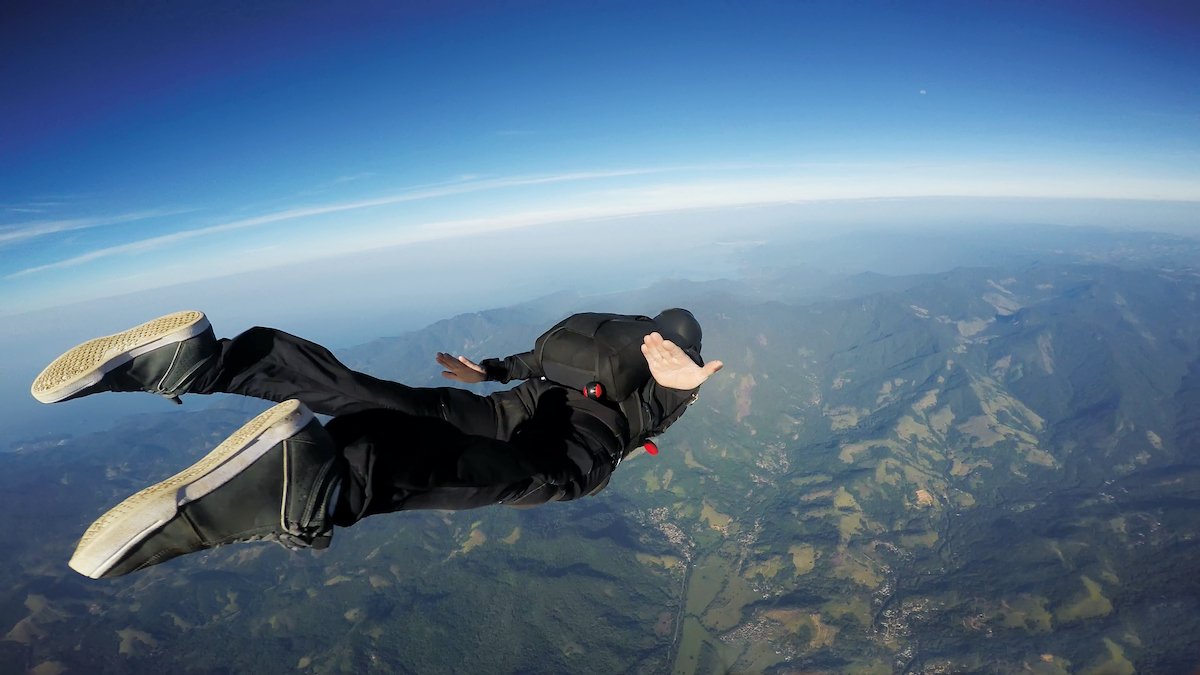
Don’t Overprepare
Overpreparation was something that both Sarah and Jackson warned against. While it’s important to visualize how your extreme adventure will go, if you get too locked in to one idea, you won’t be able to react when conditions change.
“The ability to bail is paramount to an activity like mountaineering, in which the mountains couldn’t care less whether you’ve been planning this for weeks or months or years.”
Be Ready to Pivot
Every time Jackson goes out mountaineering, alone or as a guide, he shows up fully prepared to get right back in the car and go home. The ability to bail is paramount to an activity like mountaineering, in which the mountains couldn’t care less whether you’ve been planning this for weeks or months or years. It’s important to only go for the summit if all signs point yes and not to get caught up in summit fever, which can land you in hot water fast.
Jackson stressed the ability to pivot halfway through the experience. While he plans out his routes extensively, he also knows that some things will be out of his control, and he needs to be able to react to ever-changing conditions in an alpine setting. Especially if he’s in an unfamiliar place, he wants to have as much information as possible, but with some details of the trip left open-ended. This helps him be nimble and prevents him from being too locked in to a certain route.
Fixation Breeds Anxiety
Sarah, months before we spoke, had taken a 16-knot downwinder, which means as she landed, the wind was pushing her at 20-30 miles per hour toward the ground. When she hit the ground, she was very quickly going much slower. She tore her meniscus.
She was lucky, actually, because it could have been much worse. She could have broken her legs or her back. After her recovery, on her first few jumps back, she found she was overpreparing a little. She would really fixate on what she’d do in this next skydive, how her canopy was gonna fly. At what point when she’s pulling on her toggles does the canopy go straight overhead? When does it go back behind her? Looking back at it, she thinks she needed some of those thought processes to quell her anxiety about being re-injured. As she got further from her injury, though, she found she didn’t have to prepare quite that much.
“When you’re doing challenging things, it’s important not to think about the challenge of it,” Sarah told me. The main advice she gives to skydivers less experienced than her is not to overthink it. She remembered doing a jump course with somebody who overthought a lot, and they ended up riding the plane back down a few times, eventually never jumping again. That’s a big reason she tells people to just relax, focus on your breath, and trust that you’ll have a good jump. Then again, someone she told that to once broke their leg on landing, so maybe don’t relax too much.
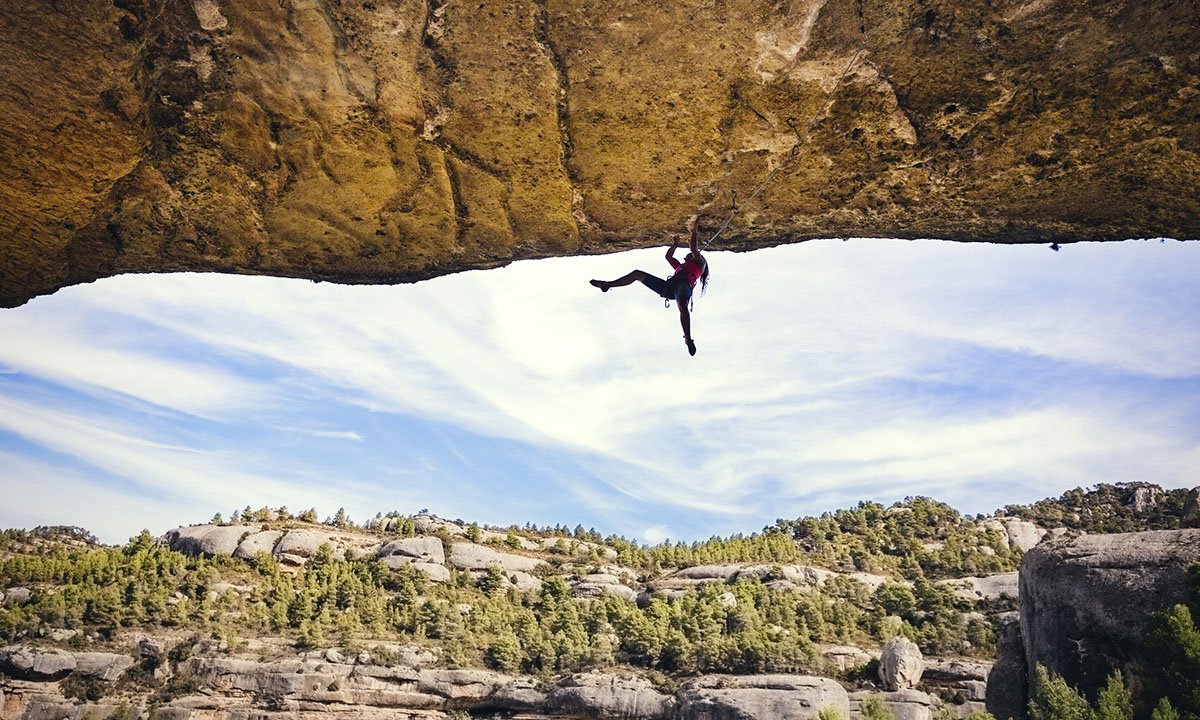
Know Your Tools
Sports psychology can offer many tools, such as visualization, self-talk, and performance routines to help you prepare mentally for your extreme adventure. Research will give you options, but experience will show you what works best in your personal case.
Physicality
Here’s another example of how physical and mental preparation overlap. Before Sarah flies, she wants to ingrain inside herself the physicality that she’ll need to focus on in her jump. Especially when you’re attaining the early categories of your skydiving qualifications, starting to learn turn maneuvers, she said, “You’ll lay down on the ground, practice arching, practice looking at your altimeter every five seconds,” and just generally how to adjust your body the way you need to in flight. She recommends acting out that physicality with the intention to do it in the sky, helping you build some muscle memory beforehand. Similarly, Jackson has spent lots of time rehearsing his mountaineering rescue skills. Having a sense, in your body, of what you’ll need to do in an emergency situation will do a lot to calm your nerves regarding what could actually happen.
Visualization
Sarah uses visualization in tandem with her physicality to prepare for her jumps. Especially when jumping with someone else, she’ll picture how it’s going to go. Otherwise, you can get lost in the experience easily. Jackson, when preparing his route and researching conditions, may use 3D mapping to consider what he’ll be undertaking. He’ll consider the angle of certain slopes and what that will look like in real time. He may also try to visualize how he himself will feel at a certain point in his ascent, preparing a benchmark with which he can later check in on himself.
Intuition
Jackson said, “Feeling and intuition are not exactly the same thing but [they’re] close cousins and should be monitored.” He feels intuition is a tool in your toolkit that is often overlooked, but we can’t say enough about it. You’ll hear stories all the time of gut instincts that have saved people or, when ignored, have hurt them. It’s a skill in and of itself to lean into that intuition and recognize it for what it is.
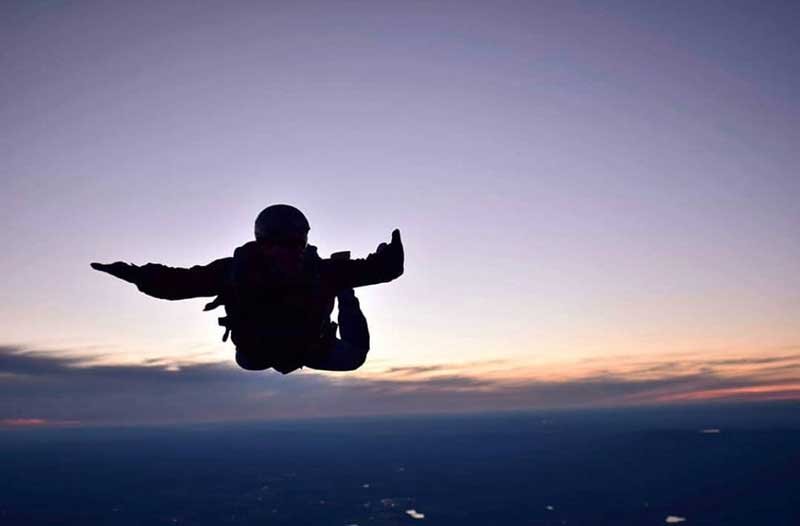
Breathe
This is a big one. Both experts stressed returning to your breath, focusing on it, and using it as a tool to take on the task before you.
To Sarah, the experience of skydiving is definitively connected to mindfulness. When you’re flying, nothing else matters but what altitude you’re at, how soon you have to pull your parachute, or whether or not you have time to make that maneuver. She recalled her first solo jump, how fast her heart was beating, how sweaty her palms were. Her goal was to do three practice touches on the handle for her parachute, but for the first five seconds she was in the air, she didn’t breathe. Her instructors reminded her to breathe, helped guide her hand toward the handle, and she was able to regain control. It’s a principle that she learned in wilderness therapy, too, that if you’re able to control your breath, it becomes way easier to control these other emotions you’ve got going on.
Jackson noted, too, that really, breath is all we have. At the very core of things, we can control, or hope to control, our breath. From there, you have to start at the bottom and work your way up. Block out the big picture, and know you just have to put one foot there and another there, and you can start to make your way.
“Really, breath is all we have. At the very core of things, we can control, or hope to control, our breath. From there, you have to start at the bottom and work your way up. Block out the big picture, and know you just have to put one foot there and another there, and you can start to make your way.”
Distraction
“I’ll also tell people to hum a motown song, or like some old blues, something like that, something goofy. Steely Dan, whatever,” Jackson told me. “Something goofy and somewhat ironic that puts you back at the barbecue.” Digging into the psychology of this a little, he said it helps give you a sense of normalcy, not letting what you’re doing get bigger than it is. Especially for folks who don’t spend a lot of time in the mountains, it can be such an alien experience. Alpine settings can feel almost forbidden to humans. So, something more familiar can help remind you, “Oh, I can move this way, I am in control of my breath, I can drink water right now, I can do all the things I need to do to make myself feel like myself.”
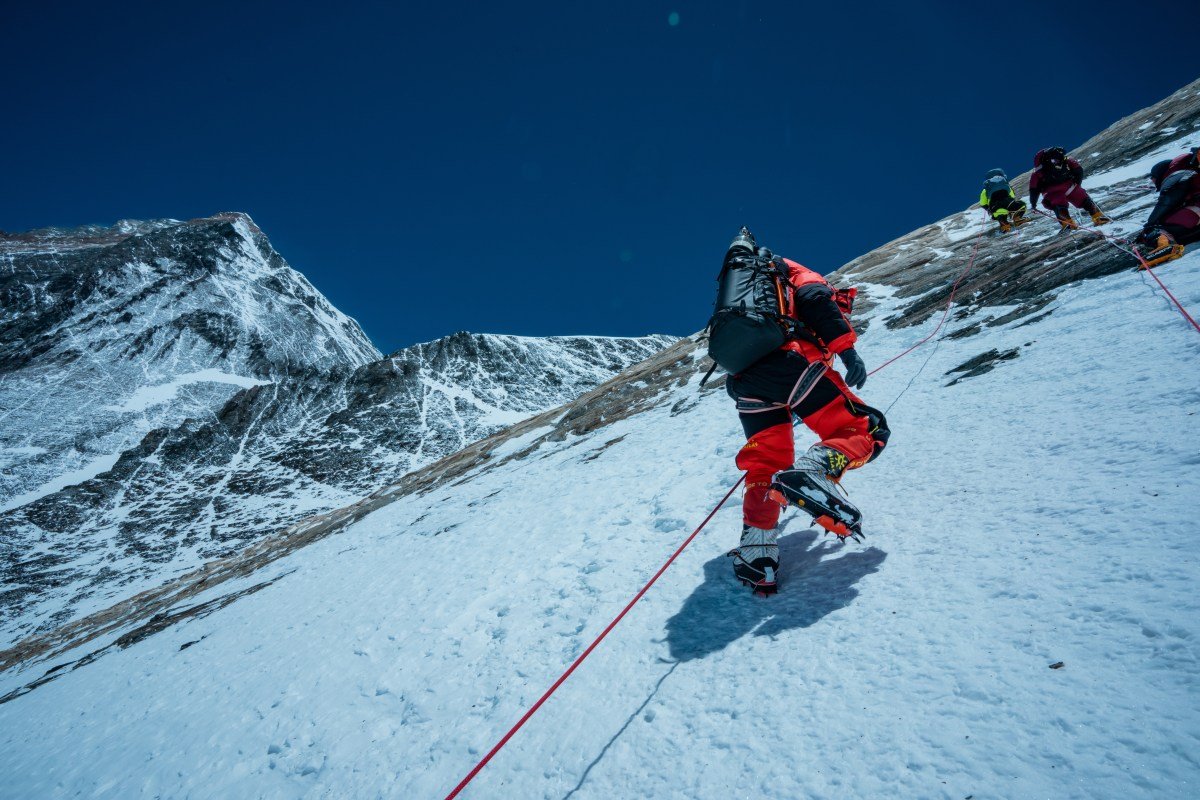
It’ll Be Over Before You Know It
Sarah commented on how much time slows down when skydiving. It only lasts two minutes or so, but while you’re up there, it feels like 10. Still, it never seems to last quite long enough. She wants to tell people prone to overthinking that they’ll be on the ground before they know it, so have a good time on the way down. On Sarah’s initial jumps, even when she struggled to catch her breath at first, she recalls that feeling of making it back to Earth. That accomplishment, having faced that fear, having jumped out of a plane by herself, is everything.
For folks seeking out extreme adventures, motivation is not often the issue. A lot of your tools will center around preparing for a few crucial moments while not getting too lost in the experience itself. There’s a fine line there between challenging yourself without getting in over your head. Jackson likes to get in 3-5% over his head at best. “You gotta search,” he told me, “for this weird little space on the spectrum of biting just a little bit more off than you can chew, but not too much that you can’t swallow.”
“You gotta search for this weird little space on the spectrum of biting just a little bit more off than you can chew, but not too much that you can’t swallow.”
—Jackson Kramer




